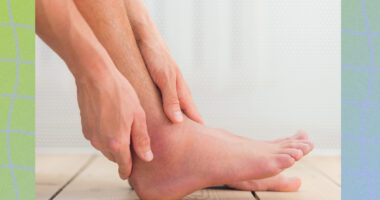
Doctor Jennifer Robinson verified that citrus fruits “may play a role in preventing certain cancers“, such as bowel cancer, prostate cancer, and breast cancer. Citing research conducted in Japan, participants who consumed citrus fruits three time per week were less likely to get cancer than those who consumed citrus fruits less than twice per week. Doctor Robinson cautioned that the research isn’t “clear-cut”, but it did show that “citrus might help fend off several types of cancer”.
The American Institute for Cancer Research noted that oranges, a type of citrus fruit, could provide antioxidant “and other forms of protection against cancer”.
Meanwhile, there is “strong” evidence that foods containing dietary fibre have a “probable” chance of decreasing colorectal cancer.
Colorectal cancer
Also known as bowel cancer, the NHS warned that a “large body of evidence” suggests that a diet high in red and processed meat could increase your risk of bowel cancer.
Moreover, there’s evidence that a diet high in fibre could help reduce your bowel cancer risk.
READ MORE: Cancer – Women who have endometriosis may have 2.6 greater risk of an ovarian tumour
Citrus fruits, for example, are a good source of fibre, adding to the theory that they could help to reduce cancer risk.
READ RELATED: Covid vaccine: The side effect appearing up to '1 month' after getting the Pfizer booster
Another medical expert, Doctor Dan Brennan confirmed that citrus fruits are “high in phytonutrients, including flavonoids”.
According to research, Doctor Brennan verified, flavonoids “may help prevent the development of certain types of cancer”.
By including fruits into your daily diet, you are on your way to having a healthy and varied diet.
DON’T MISS
Then one quarter can be made up of either potatoes, brown rice, bread, or pasta, and the other quarter could be chicken, fish, beans, or eggs.
Fruits, vegetables, and whole grains should be eaten every day, with people aiming for at least five portions of fruit and vegetables.
If you do consume dairy, it’s advisable to opt for low-sugar, and low-fat options.
Portion sizes:
- Dried pasta or rice – one portion is two handfuls
- Potatoes – one portion is about the size of your fist
- Baked beans – one portion is half a standard 400g tin
- Carrots, peas or sweetcorn – one portion is three heaped serving spoons
- Unsalted nuts and seeds – one portion is the amount that fits in your palm
- Hard cheese (e.g. cheddar) – one portion is the size of two thumbs
- Chicken (boneless and skinless) – one portion is about half the size of your hand
- Apple – one portion is one apple.
Source: Daily Express








